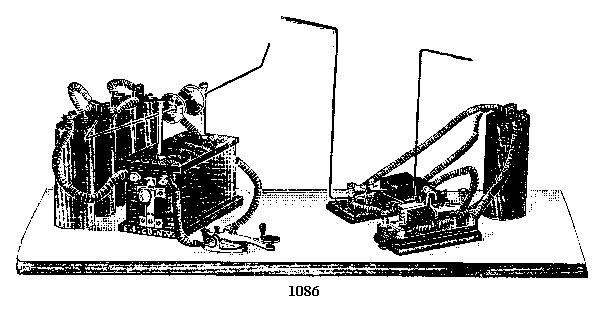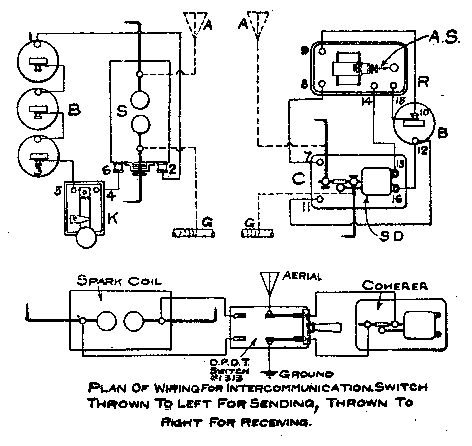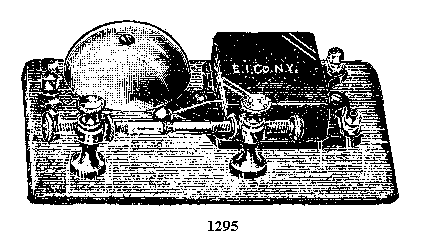| No. 1086 Complete "Telimco" No. 2 Comprises: |
| |
| 1 one-inch spark coil, special high tension, polished hardwood case; French improved vibrator, all trimmings polished brass (Not mailable) No. 1088. | $4.50 |
| 1 pair adjustable brass jump spark balls, 1 ¾ inches diameter, including polished supporting stands, binding posts and two "send" wires. No. 1111. | .90 |
| 1 coherer with Automatic Decoherer and Sounder combined, including two "catch" wires. No. 1097. | 1.00 |
| 1 Seventy-five Ohm, Sensitive Relay, No. 1108. | 1.10 |
| 5 Cells Dry Battery (Not mailable) 2½ x 6 inches, No. 1001, @ 16c. | .80 |
| COMPLETE OUTFIT, boxed | 8.50 |
Where two complete sets for intercommunication are ordered we furnish 2 extra D. P. D. T. Switches, No. 1313, free of charge. See diagram, page 64.
| No. | 1290 | Complete "Telimco" Wireless Telegraph Outfit No. 3 (Patent applied for,) consists of: |
| " | 1087 | One-half inch special high tension Spark Coil, enclosed in polished hardwood box, with automatic double adjustable vibrator, brass posts and trimmings; size 7 x 4¼ x 4 inches | $3.10 |
| " | 1097 | One Coherer, with Decoherer and Sounder combined, with nickel plated posts and trimmings, all mounted on polished base, and 2 Receiving Wires. | 1.00 |
| " | 1107 | One Fifty Ohm Sensitive Relay, brass trimmings, bases polished wood. | 1.00 |
| " | 1111 | Two polished Brass Jump Spark Balls, Two "Sender" Wires; and Stands. | .90 |
| " | 1118 | One "Strap" Key, nickel trimmings. | .20 |
| " | 1001 | Four Extra Strong Dry Cells, 2½ x 6 in. Three for sending and one for receiving station, 16 cents each. | .64 |
| | All necessary wiring plans, diagrams, etc. | .20 |
| PRICE OF COMPLETE OUTFIT. | 7.00 |
May be shipped by Express or Freight to any part of the world.
| | The "Telim" outfit comprises the following parts: |
| No. | 1088 | 1 One inch Spark Coil, as per page 47. | $4 50 |
| " | 1111 | 2 Adjustable Jump Spark Balls, 1¾ inches diam., with rods and stands. | 90 |
| " | 1098 | 1 Auto-coherer with catch wires. | 80 |
| " | 1118 | 1 Strap Key. | 20 |
| " | 1024 | 1 Pony Telephone Receiver. | 35 |
| " | 1001 | 4 Dry Batteries, each 16 cents. | 64 |
| | All necessary wiring, instructions, diagrams, etc. necessary for setting up. | 10 |
| 1120 Complete "Telim" Wireless Outfit. | 7 35 |
When two complete stations for intercommunication are ordered, we will supply the necessary switches, three point keys, extra diagrams, etc., free of charge.









